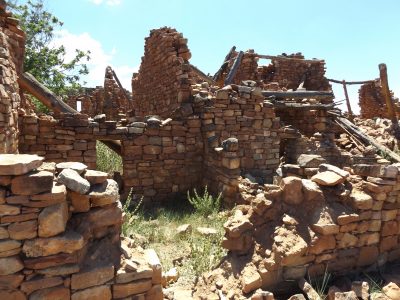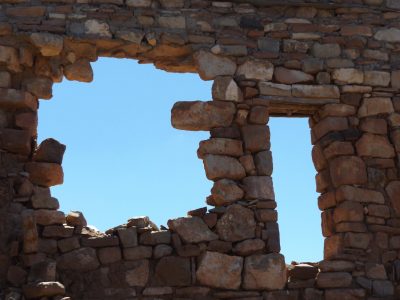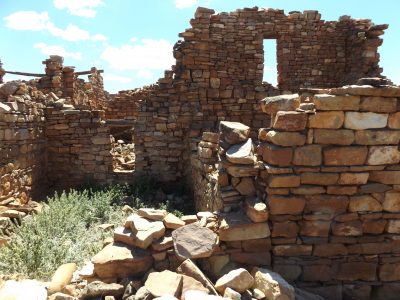“Caw Caw,” the ravens call as we approach Kinishba. These ruins are located at the base of the Sawtooth Mountains on the Apache reservation. “Kinishba” means “brown brick house” in the Apache language and the large rectangular structures are masterpieces of Mogollon architecture. When the village was in full bloom over eight hundred years ago thousands of people lived here. Visitors to Kinishba will discover over six hundred rooms and multistoried sections of some of the buildings still standing.
Visiting Kinishba is not as difficult as it used to be. It used to be that as soon as one turned off the Beeline Highway onto the reservation you kept a careful watch on your odometer until it had clicked 12.1 miles and turned onto an unmarked dirt road. Nowadays there is a big brown forest service sign that tells you where to turn. You do however need a reservation hiking permit. The road rolls for a few miles past corrals and horses but as you approach Kinishba the structures rise up from the earth in a way that blends in beautifully with the Sawtooth Mountains in the background. In some ways the multi storied ruins resemble an abandoned apartment building. During the height of its occupation, through the 12th and 14th centuries, Kinishba may have been home to as many as one thousand five hundred human beings and was probably the cultural center for the region. Kinishba is believed to share traits of both the Mogollon and Anasazi cultures. Both Hopi and Zuni peoples claim ancestral ties. One summer many years ago when I was visiting the site an Apache father was there with an eagle feather, a fistful of corn pollen and a bright yellow invitation to his daughter’s naichee ceremony. He intended to leave the invitation for spirits of the ancients, so they might bless his daughter during the ceremony. I noticed that when he carefully placed his gifts on the rock beside the ancient spring there were already eagle feathers which others had left previously.
Some scholars believe that Kinishba may have been the ruins the Coronado expedition visited in 1540 and called Chiciticale. The first archaeologist to visit was Adolph Bandelier in 1892. The first organized and extensive excavations at Kinishba were led by Byron Cummings from 1931 to 1940. Cummings was founder of the University of Arizona archaeology department as well as the Arizona State Museum. Cummings had started as a classics professor and when he discovered the prehistoric ruins of the southwest he wondered aloud why we weren’t studying the wonders in our own backyard instead of the distant Mediterranean. Cummings also wrote of being the first white man to view sacred Rainbow Bridge in Utah. His account of traveling the backcountry for days before waking up at sunrise and racing a mule under the arch to beat his rival explorers is a sharp contrast to the present when Lake Powell tour boats make daily pilgrimages, floating right up to Rainbow Bridge.
As he was nearing retirement Cummings began to restore Kinishba. He was hoping to provide the Apache with a Mesa Verde style tourist trap. He built a small museum just beyond the ruins that was supposed to provide Apache craftsmen a chance to sell their jewelry, pottery, and art. Cummings came armed with the usual assortment of university graduate students in the summertime but he was also able to interest some of the local Apache in the project. In particular David Kane, Chester Holden, and Turner Thompson were all tribal members who spent at least five years working on the project. Turner Thompson often camped with Cummings inside the museum as it was being built. The two men became fast friends and I have often wondered if their friendship was aided by Thompson’s deafness. When the museum burned down the project was temporarily abandoned and never restarted. Now the two ruins, Kinishba and the museum stand side by side, both of them with trees poking branches through windows.
While Cummings and his crew were excavating they discovered amazing things like the graves of two tiny children wearing bracelets with over 17,000 beads of red pipestone, turquoise, and gray slate. There was one room which seemed to serve as a pottery show room, holding only shards of wonderfully detailed, intricately painted pottery. As one wanders the roughly rectangular shape of Kinishba you come to a clearing in the middle. This large patio served as a ceremonial space, a courtyard where dancers, drummers and audience could gather. An altar was discovered with painted deer and antelope jaw bones. The stone altar was decorated with a painting of a kachina type of figure wearing a storm cloud headdress with lightning bolts painted him above him and corn stalks painted on the sides.
The brown brick ruins at Kinishba are huge and beautiful and architecturally they blend in beautifully with the Sawtooth Mountains which serve as a majestic backdrop. Between the Great Depression and World War II, Kinishba was never adopted by the National Park Service nor became the type of financially lucrative tourist trap envisioned by Cummings. However if you take the time to visit Kinishba you will be glad you did.




